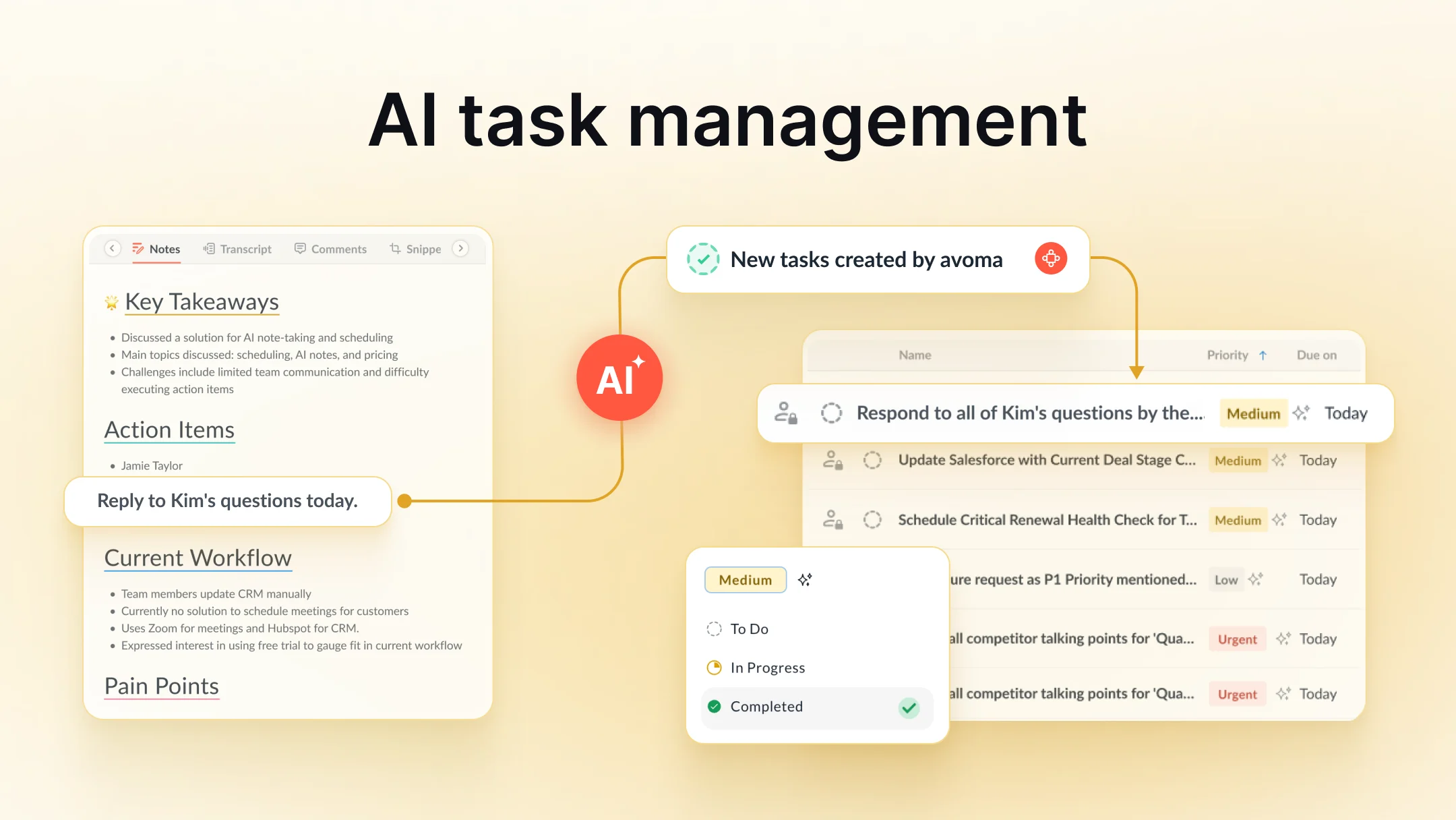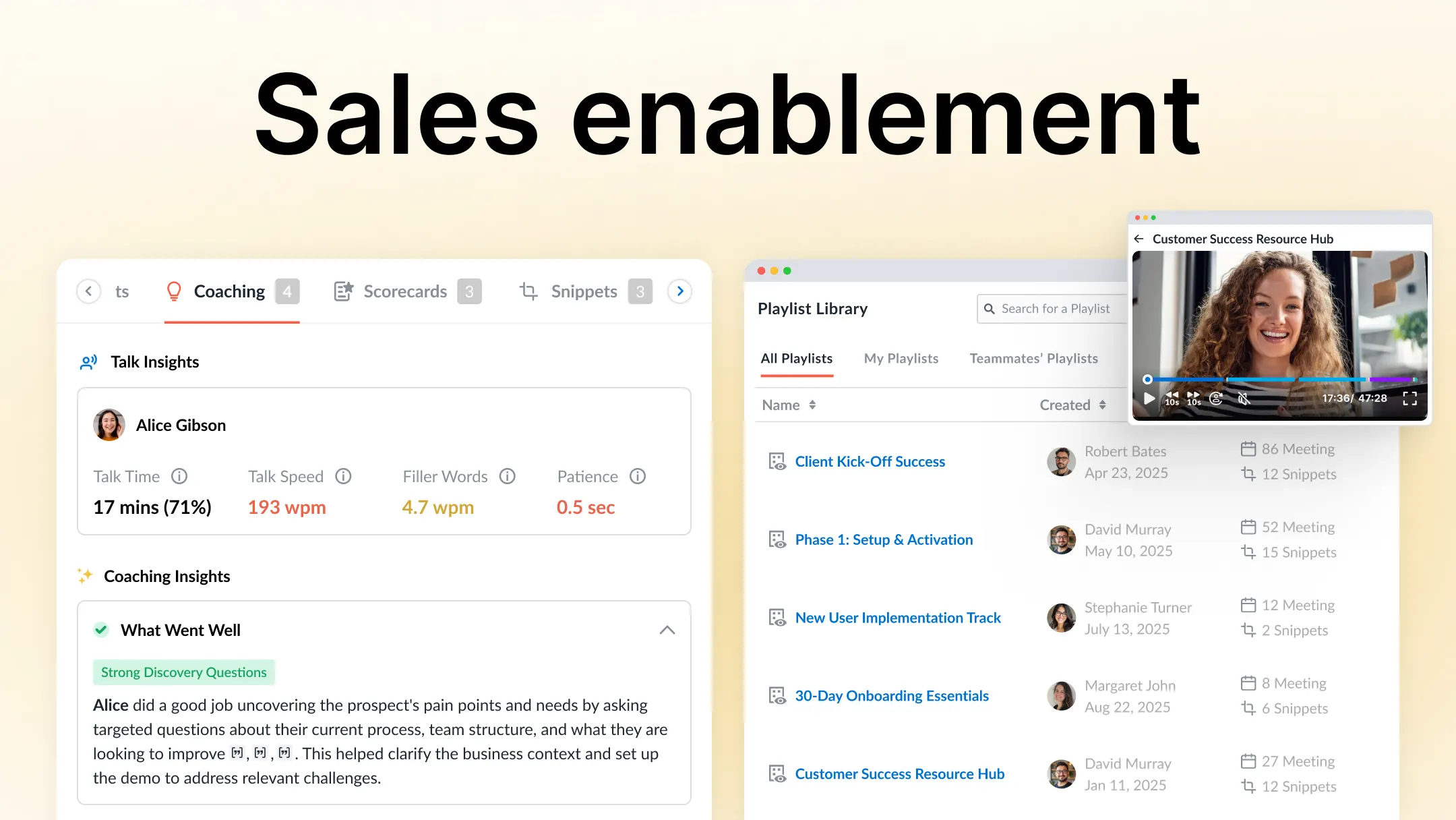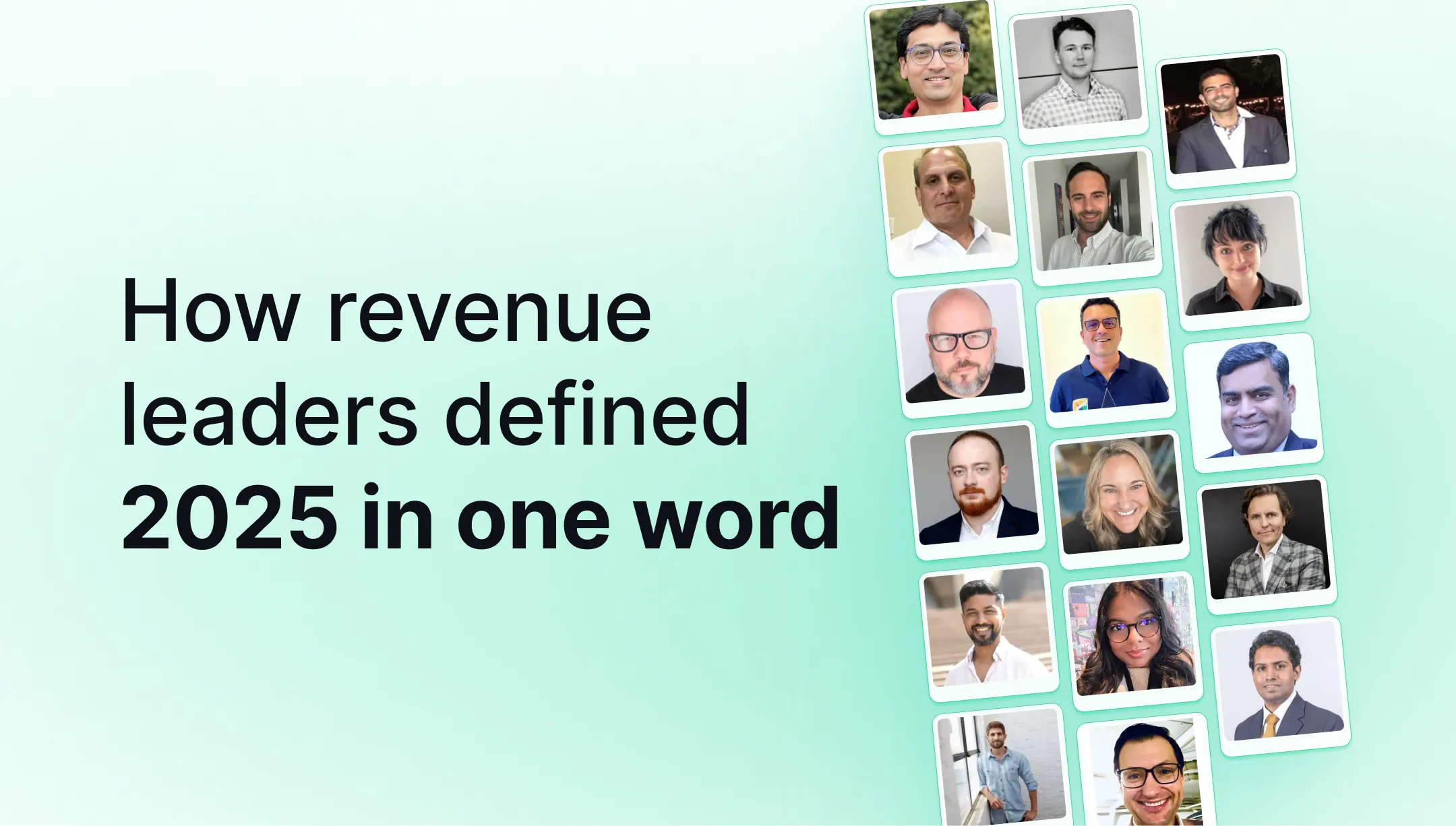How RevOps teams use revenue intelligence software
Table of Contents:
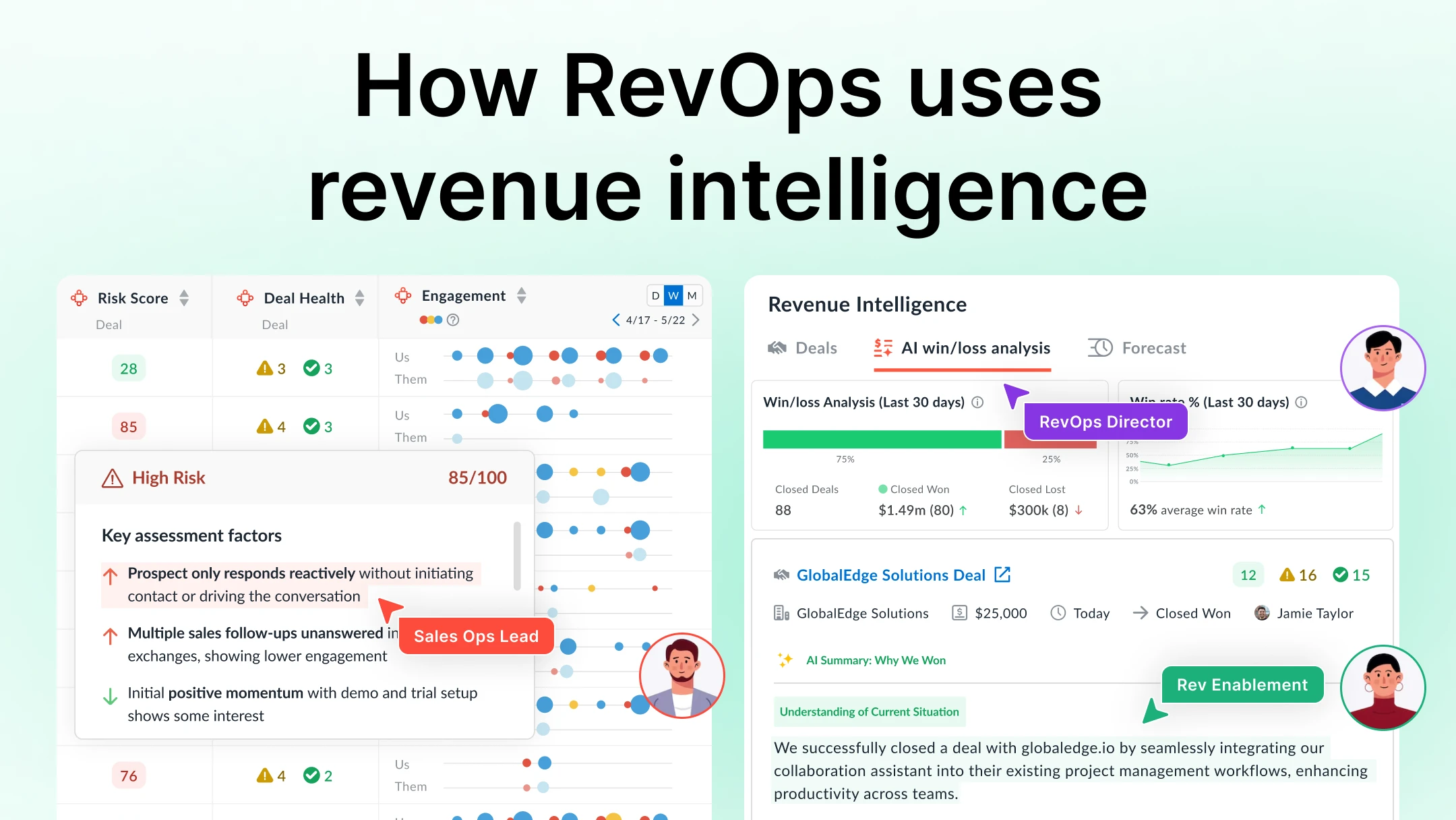
Revenue Intelligence has become core to how mature RevOps teams drive alignment, accuracy, and automation across their GTM systems.
In this guide, we’ll unpack how each RevOps role, from the strategist shaping forecasts to the specialist maintaining data hygiene, uses Avoma’s Revenue Intelligence to turn activity data into operational clarity.
TL;DR: What you’ll learn in this guide
This guide breaks down how each RevOps function contributes to predictable, scalable growth, and how Revenue Intelligence helps them get there. You’ll see how:
- Heads of RevOps use behavioral and deal data to boost forecast accuracy by up to 32% and drive alignment across GTM teams.
- Systems Managers automate CRM updates and unify tools, saving 8–10 hours per week with two-way field mapping and native integrations.
- Sales Ops connects activity trends and deal outcomes through AI Win-Loss Analysis and Deal Health insights, enabling benchmarking of team performance and a clear view of how behaviors drive outcomes.
- Ops leaders spot friction points and validate playbooks, reducing cycle times by 18%.
- Planning Managers model capacity and build reliable forecasts from real-time Deal Risk and Pipeline Performance data.
- RevOps Specialists keep CRM data 35% cleaner and streamline recurring reporting using live engagement insights.
When Revenue Intelligence sits at the core of your GTM motion, RevOps shifts from reporting on what happened to anticipating what’s next, aligning people, process, and data around growth that’s predictable by design.
Before diving into each role, it’s worth understanding why revenue intelligence has become a must-have for RevOps teams.
Why RevOps teams are turning to revenue intelligence
RevOps teams are under pressure to deliver predictability, precision, and efficiency, yet most rely on static CRM data that tells what happened, not why.
Revenue intelligence closes that gap by analyzing real customer conversations and engagement alongside your CRM data, giving RevOps a clear view of what drives pipeline health, deal risk, and forecast accuracy.
In 2025, leading RevOps orgs used revenue intelligence to:
- Automate data capture and reporting
- Align GTM teams with a single source of truth
- Improve forecast accuracy with real behavioral and engagement signals
- Continuously optimize process and performance
Tools like Avoma bring this visibility directly into the systems teams already use, with automated meeting capture, conversation insights, and deal intelligence that feed straight into CRM and analytics platforms. And because Avoma keeps data in sync across systems, RevOps teams can trust that every number and insight is always up-to-date.
However, to understand how revenue intelligence fits into daily operations, it is helpful to examine how RevOps teams are structured as they grow and how their needs evolve at each stage.
How a RevOps org typically scales
Every company’s RevOps org looks different, but the structure usually evolves through three key stages:
Early stage
A single RevOps generalist wears all the hats, from CRM management to data reporting and process documentation.
At this stage, RevOps often struggles with the basics. There's no single system of record, data is inconsistent, and reps rarely update the CRM.
Avoma helps automate meeting capture, notes, and CRM updates, giving RevOps clean, reliable data and better visibility without adding headcount or process overhead. This automation establishes a strong data foundation that supports accurate reporting and forecasting as the business grows.
Growth stage
As the GTM motion matures, RevOps typically adds one or two system admins, Sales/CS Ops, and a Head of RevOps to own strategy.
Roles start to specialize with clear ownership of tools, data, and forecasting. But new challenges emerge where processes become inconsistent, tools multiply, and scaling team performance gets harder.
Avoma brings structure through conversation intelligence, playbook tracking, and deal insights, helping RevOps enforce sales methodology and scale enablement effectively. The result is greater operational consistency and more reliable forecasting as GTM complexity increases.
Enterprise stage
Larger organizations eventually split RevOps into dedicated teams for systems, data, process, and planning, each led by specialized managers.
At this point, the pain shifts toward siloed systems, fragmented data, and complex forecasting models.
Avoma integrates deeply across CRM and analytics tools with two-way data sync and revenue intelligence, giving leadership a unified, predictive view of revenue performance. This integration enables true cross-functional alignment and predictable forecasting at scale.
As these roles specialize, the way they use revenue intelligence also changes. From strategic forecasting at the leadership level to data cleanup and process optimization at the execution level, each role extracts value differently.
What RevOps teams are asking for in revenue intelligence
In our customer conversations, RevOps teams consistently highlight three major needs:
- Automated CRM hygiene and data capture: Two-way CRM field mapping and AI-generated pain points, goals, next steps, methodology fields, and more reduce manual data entry and improve reporting reliability.
- Complete visibility: Cross-pipeline reporting and multi-channel activity capture across email, calls, and chat provide the context missing in standard CRM dashboards.
- Adoption and governance: Streamlined rollout, role-based controls, and audit visibility help RevOps ensure consistent adoption, data integrity, and compliance across GTM teams.
Tools like Avoma address these needs by turning fragmented activity data into actionable, unified insights that help RevOps lead with confidence.
How RevOps teams use Revenue Intelligence software
Here’s how every role in a modern RevOps org benefits from Revenue Intelligence software (and how Avoma helps them do it).
If your organization has one or more of these merged into a single role, focus on the functions they perform to understand how Revenue Intelligence should support their work.
Head of revenue operations: Driving forecast accuracy and GTM alignment
As Head of RevOps, your goal is to make revenue predictable by aligning every GTM team around shared visibility and leading indicators, not lagging metrics.
Many RevOps leaders use Avoma as a forecasting and visibility layer that integrates with their CRM and replaces manual dashboards. It combines conversation insights, deal boards, and pipeline performance data to make forecasts transparent and coaching more focused.
How to turn strategy into execution with revenue intelligence
- Get a unified pipeline view: See how your pipeline evolved over time — what was added, expanded, pushed, won, or lost — to understand deal movement and conversion trends across teams.
- Get all deal insights in one view: Track deal health, engagement, methodology scoring, risk, and CRM data in one dashboard.
- Spot execution gaps early: Use revenue insights to identify where deals stall, from weak discovery to follow-up fatigue.
“Avoma helps with pipeline reviews because they map the activities on a timeline and give each deal a health score. That way our managers can focus coaching on deals that need the most attention.” — Avoma user
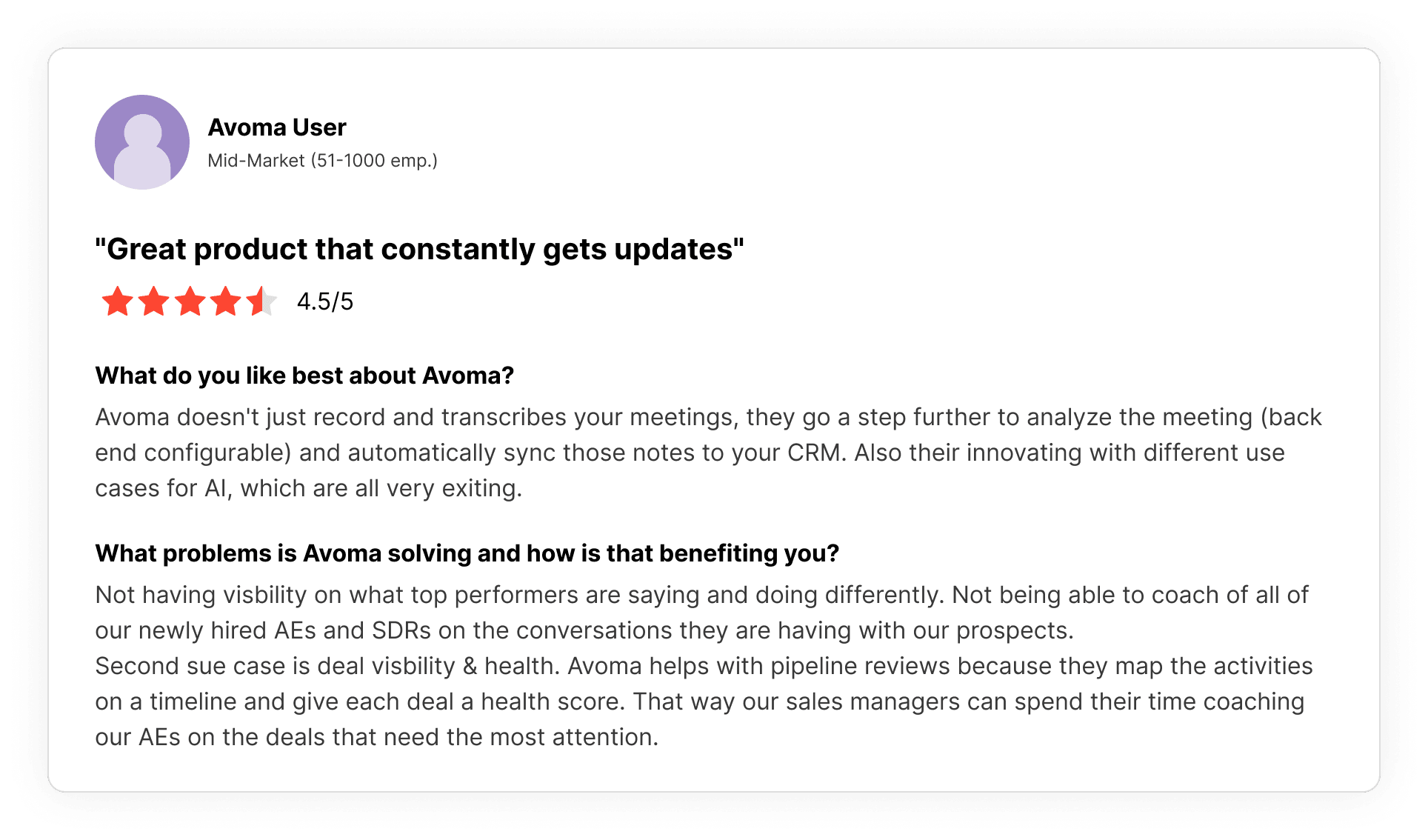
“Avoma is allowing effective coaching from our revenue leadership. It allows them to analyze each conversation our team is having, which in turn provides the ability to train effectively.” — Avoma user
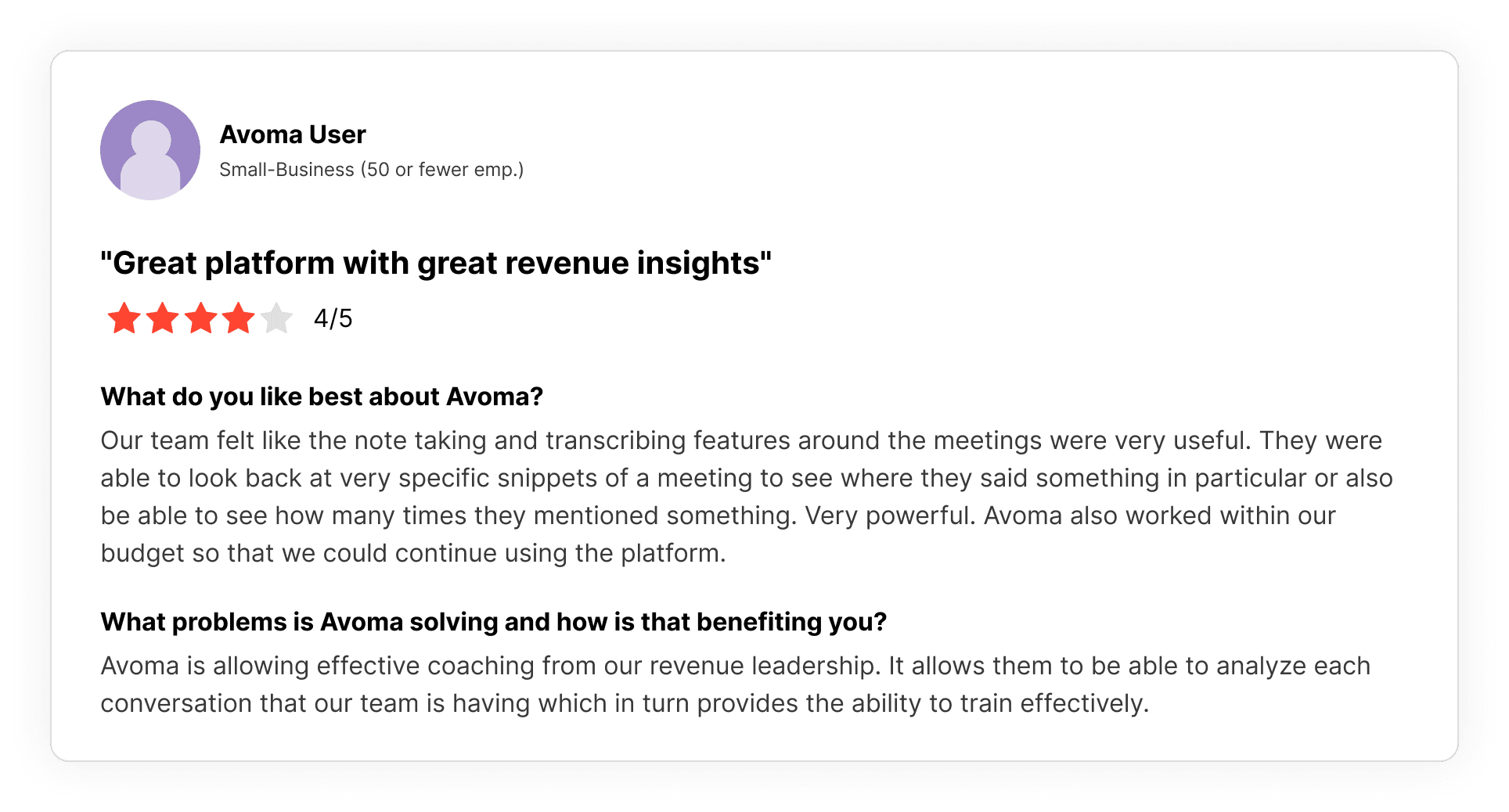
- Forecast with confidence: Use deal health scores that combine real-time engagement and CRM data to improve forecast accuracy. Confidently submit forecasts, validate roll-ups, and track team performance to drive predictable revenue growth.
- Align GTM teams around shared truth: Share forecast reports across sales, marketing, and CS to drive predictable execution.
A SaaS company with 45 account executives used Avoma’s forecasting data to reduce missed forecast targets by 28% within one quarter.
ROI: Up to 32% improvement in forecast accuracy and 25% faster pipeline reviews, giving leadership confidence in real-time revenue visibility.
Revenue systems manager: Ensuring automation uptime and data integrity
You keep the GTM stack running cleanly and reliably. Revenue intelligence tools like Avoma help streamline those connections while complementing your existing CRM and enablement stack.
How to simplify your tech stack with revenue intelligence
- Automate CRM data sync: Avoma’s field-level mapping automatically updates Salesforce or HubSpot fields, including custom objects, with insights and next steps from calls.
“Really smooth transcription and auto-summarization that I used to have to do manually. It eliminated three tools I was using and consolidated everything into one. And it syncs the summaries, recordings, and transcripts to my CRM.” — Charles E., VP of Revenue

- Centralize conversation and deal data: Consolidate activity, engagement, sentiment, and deal health insights into a single source of truth.
- Maintain consistent integrations: Avoma connects with your CRM to sync deal stages and activity data, enriching it with engagement and risk insights for cleaner reporting across tools.
- Simplify governance: Features such as Manage Targets and Forecast Settings standardize processes while maintaining flexibility for connected tools.
A SaaS company with 40 AEs reduced CRM admin time by 10 hours per week after integrating Avoma’s revenue intelligence with HubSpot.
ROI: RevOps teams save 8–10 hours weekly and see 40% fewer CRM data errors after automating data capture.
Revenue data analyst: Improving data accuracy and insight depth
You turn raw CRM data into reliable insights that guide GTM performance.
How to deliver deeper reporting with revenue intelligence
- Visualize what drives performance: Track engagement, conversion, and velocity using reports and pipeline trend data.
- Connect actions to outcomes: Use AI Win-Loss and deal risk scoring to link rep behavior with conversion rates.
- Automate analytics across pipelines: For high-velocity teams, Avoma aggregates pipeline data into unified dashboards, replacing manual spreadsheets.
- Enable self-serve insights: Give GTM leaders direct access to dashboards rather than static reports.
A SaaS company with 50 AEs used Avoma’s dashboards to reduce ad hoc data requests by 70%, allowing analysts to focus on strategy instead of cleanup.
ROI: Teams cut report prep time by 50% and increased leadership visibility into deal health by 3×.
Revenue process manager: Optimizing sales velocity and process consistency
You remove friction from GTM workflows, ensuring every process accelerates deal flow rather than slowing it down.
How to optimize GTM workflows with revenue intelligence
- Identify bottlenecks: Use cross-channel activity capture and deal health signals to see where deals lose momentum.
- Validate compliance: Use AI methodology tracking to ensure reps consistently follow qualification and handoff rules.
“The ability to automatically document all of our company's calls, both internal and external, has changed how we do business. Our sales process has improved 10x, and there is no longer a reason to have a disagreement on ‘I never said that.’ It also integrates nicely with our CRM system. We use it for every call we have.” — Brian K., Avoma customer
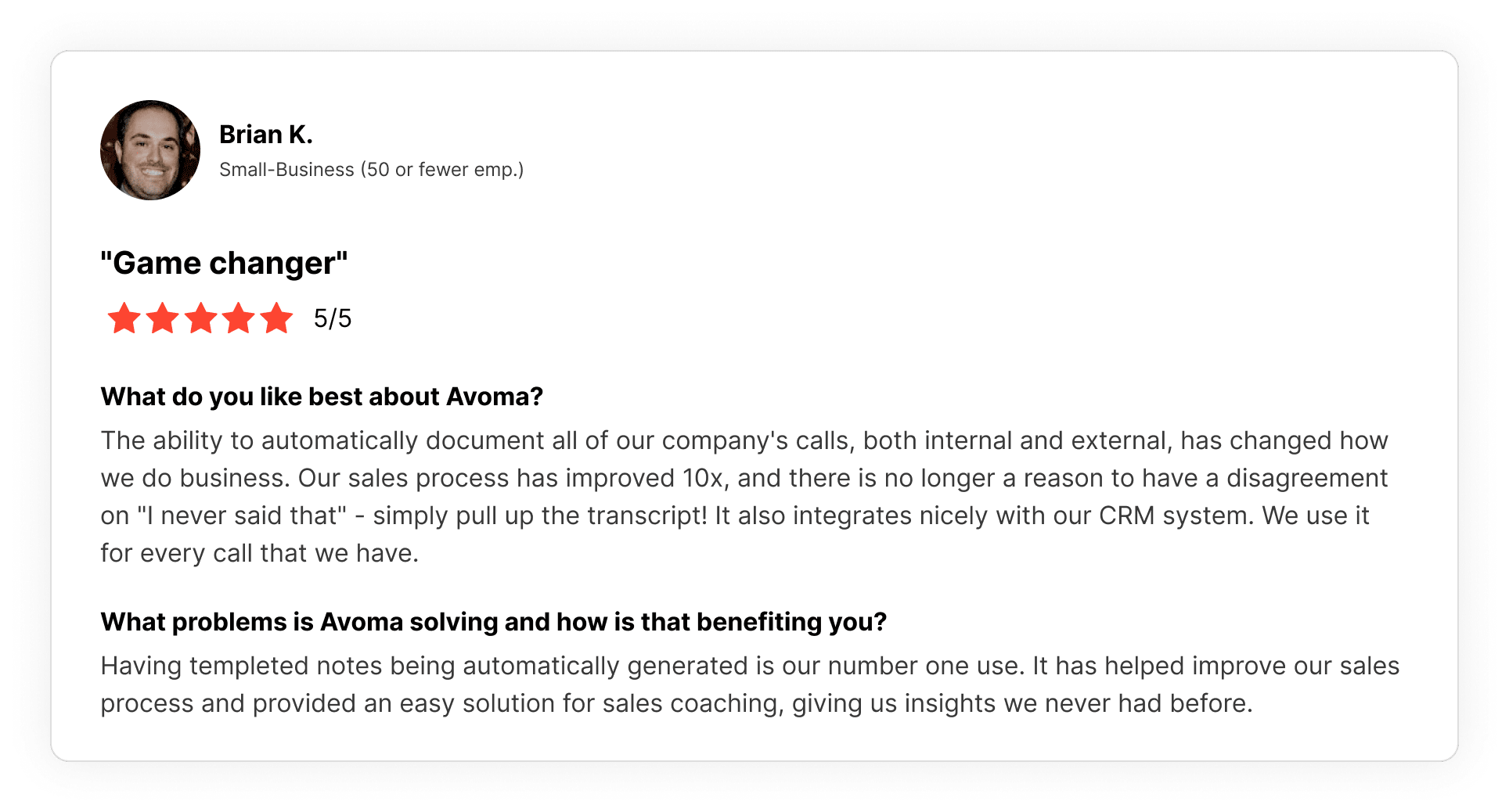
- Refine playbooks: Analyze AI Win-Loss patterns to uncover what drives higher win rates and replicate success across teams.
- Measure efficiency: Track cycle time and pipeline performance to confirm whether process changes actually speed up deals.
ROI: Process improvements led to 18% faster deal cycles and 27% better playbook adoption.
Revenue planning and strategy manager: Strengthening forecast precision and revenue predictability
Every RevOps planner knows the pain of forecast volatility when CRM numbers tell one story and buyer engagement tells another. Revenue intelligence closes that gap by combining behavioral data with pipeline metrics.
How to forecast with confidence using revenue intelligence
- Start with real engagement: Weigh deals by deal health and risk score to identify true opportunities.
- Validate assumptions: Compare CRM forecasts with conversation and engagement data to catch inflated pipeline.
“Another piece we are diving into is the sales forecasting by Avoma. Avoma's forecasting helps me make strategic decisions with confidence and hone in on what deals are real and what we should close lost. Improved forecasting has led us to a leaner and more accurate pipeline.” — Melinda M., CRO
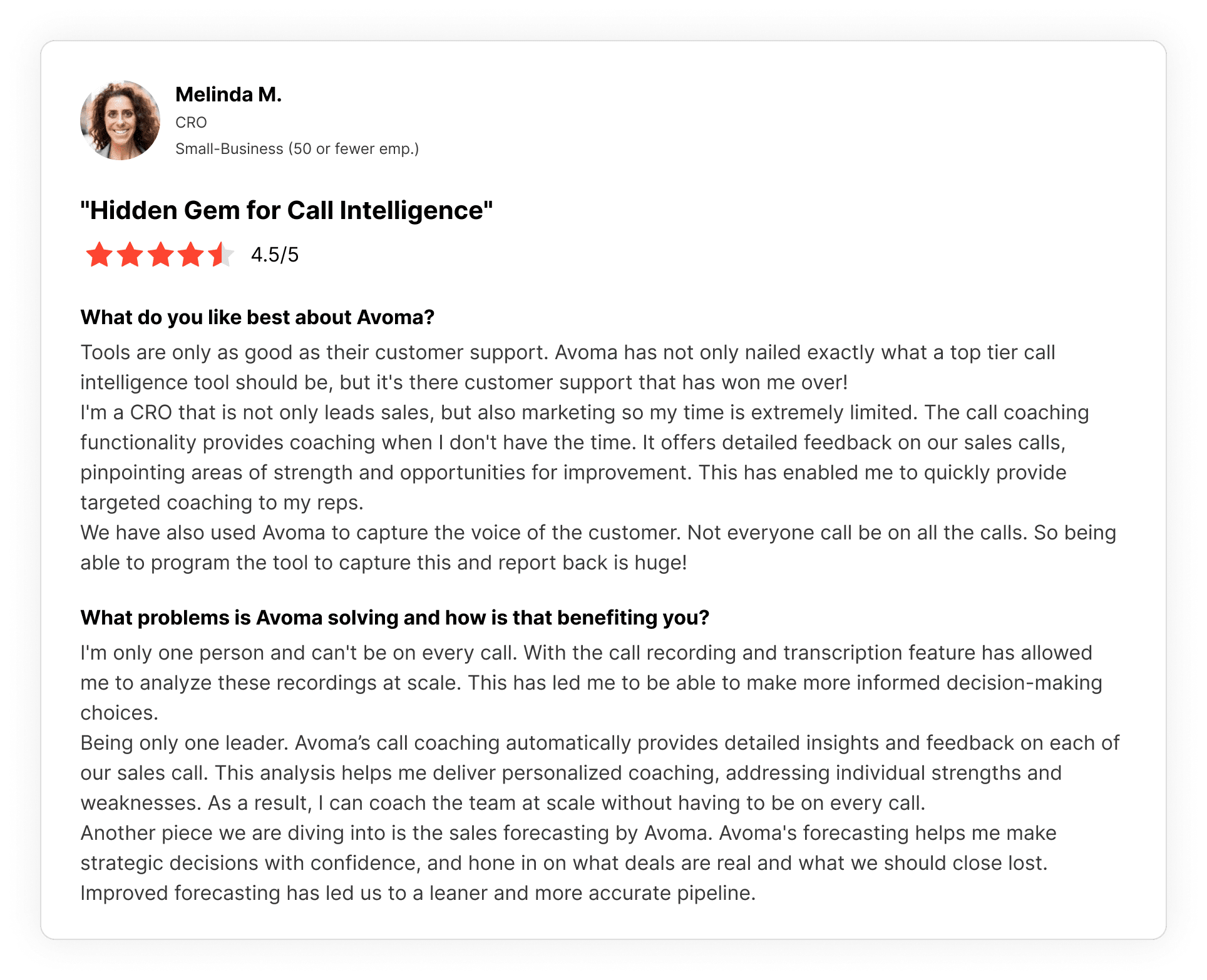
- Model scenarios: Adjust forecast settings to test outcomes based on activity patterns.
- Track performance: Use Manage Targets and Forecast dashboards to align quotas with deal momentum.
An enterprise RevOps team replaced three forecasting spreadsheets with a single Avoma dashboard, improving forecast accuracy by 32% without changing their CRM setup.
ROI: Up to 32% improvement in forecast accuracy and 40% fewer end-of-quarter revisions.
RevOps specialist or analyst: Maintaining CRM hygiene and operational efficiency
You connect people, data, and tools every day, keeping GTM operations consistent and clean.
How to boost daily efficiency with revenue intelligence
- Automate recurring reports: Use pipeline and deal summary reports to update leaders automatically.
- Fill CRM gaps automatically: Two-way sync keeps notes, follow-ups, and activities accurate without manual entry.
- Surface insights instantly: Pull deal risk and engagement summaries for pipeline reviews in seconds.
- Track adoption: Use reporting to measure data completeness and enablement metrics across the GTM org.
A mid-market SaaS company reduced weekly reporting time by 60% and improved CRM hygiene by 35% after integrating Avoma for data sync.
ROI: Save 5–8 hours weekly and increase CRM completeness by 35%.
Putting revenue intelligence to work for RevOps
Revenue intelligence delivers the most impact when RevOps teams operationalize it, not just set it up.
Tools like Avoma integrate with your CRM to provide clean activity data, behavioral insights, and real-time visibility that connects people, processes, and pipeline.
Start by automating CRM data capture, tracking engagement health, and reviewing forecasts through the lens of real activity. As adoption grows, refine playbooks, coach using deal insights, and share what works across your GTM teams.
Every RevOps organization runs differently, and your feedback helps improve how revenue intelligence supports your workflows. Try using the Revenue Intelligence feature in Avoma and let us know your feedback. Your insights help us make it even more powerful for teams like yours.
The sooner you align your data and people around real engagement, the sooner you turn visibility into predictable growth.
Frequently Asked Questions
For a RevOps team, Revenue Intelligence provides the real-time visibility, clean activity data, and behavioral signals needed to align sales, marketing, and customer success, improve data hygiene, and drive predictable revenue growth.
The main components of a revenue inteligecne solution include:
- Data capture: automated logging of calls, emails, meetings, CRM updates.
- Visibility: dashboards that show pipeline health, buyer engagement, deal risk.
- Actionability: insights that lead to coaching prompts, deal strategy adjustments, forecast validation.
Typical problems addressed:
- Manual or incomplete CRM updates leading to poor data quality.
- Forecasts based on gut feel rather than real buyer engagement.
- Lack of visibility into deals’ true status and buyer behavior.
- Siloed data across sales, marketing, and customer success.
Some of the outcomes include: improved forecast accuracy, faster pipeline reviews, cleaner CRM data, reduction of manual processes, and more reliable deal health visibility.
While it can benefit even early-stage teams, the value tends to grow when the GTM stack is mature, data volumes and complexity increase, and alignment across teams is required. The tool becomes more impactful when integrated into workflows and habits, not just installed.
Challenges include: integrating multiple data sources/tools, ensuring user adoption, cleaning up existing CRM/data hygiene, embedding the insights into coaching and workflows (not just dashboards).
Key evaluation criteria: strong CRM and tool integrations, usability across roles (RevOps, sales, marketing), automated data capture, real-time visibility, actionable insights, ability to embed into existing workflows.
Trends include: increasing use of AI/ML to surface predictive insights, deeper automation of data capture, greater consolidation of GTM tool stacks, and expanding from just sales to full revenue lifecycle (including renewals/CS).






What's stopping you from turning every conversation into actionable insights?



